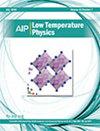ZnO sensitization by polymethine dye in photoelectrochemical cells for solar energy conversion
IF 0.8
4区 物理与天体物理
Q4 PHYSICS, APPLIED
引用次数: 0
Abstract
By sintering ZnO powder mixed with ethylene glycol, electrodes on a glass substrate with a conductive SnO2 layer were obtained. In parallel, Ti/TiO2 electrodes were obtained by anodizing a titanium foil. Electrodes based on ZnO and TiO2 were sensitized to visible light with a cationic polymethine dye. The analysis of the photoelectrochemical characteristics of the obtained electrodes showed that the dye-sensitized ZnO films in the wavelength range of 450–650 nm have a photocurrent quantum yield two-fold higher compared with TiO2. In this way, a hybrid dye-ZnO structure sensitive to visible light was formed, which can be used for the photoelectrochemical cells for solar energy conversion, as well as for the detection of DNA and proteins in biological sensors.用于太阳能转换的光电化学电池中的聚甲基染料氧化锌敏化技术
通过烧结与乙二醇混合的氧化锌粉末,在玻璃基板上获得了带有导电二氧化锡层的电极。同时,通过对钛箔进行阳极氧化处理,得到了 Ti/TiO2 电极。基于 ZnO 和 TiO2 的电极使用阳离子聚甲基染料对可见光进行敏化。对所获电极光电化学特性的分析表明,在 450-650 纳米波长范围内,染料敏化 ZnO 薄膜的光电流量子产率是 TiO2 的两倍。这样,一种对可见光敏感的混合染料-氧化锌结构就形成了,它可用于太阳能转换的光电化学电池,也可用于生物传感器中 DNA 和蛋白质的检测。
本文章由计算机程序翻译,如有差异,请以英文原文为准。
求助全文
约1分钟内获得全文
求助全文
来源期刊

Low Temperature Physics
物理-物理:应用
CiteScore
1.20
自引率
25.00%
发文量
138
审稿时长
3 months
期刊介绍:
Guided by an international editorial board, Low Temperature Physics (LTP) communicates the results of important experimental and theoretical studies conducted at low temperatures. LTP offers key work in such areas as superconductivity, magnetism, lattice dynamics, quantum liquids and crystals, cryocrystals, low-dimensional and disordered systems, electronic properties of normal metals and alloys, and critical phenomena. The journal publishes original articles on new experimental and theoretical results as well as review articles, brief communications, memoirs, and biographies.
Low Temperature Physics, a translation of the copyrighted Journal FIZIKA NIZKIKH TEMPERATUR, is a monthly journal containing English reports of current research in the field of the low temperature physics. The translation began with the 1975 issues. One volume is published annually beginning with the January issues.
 求助内容:
求助内容: 应助结果提醒方式:
应助结果提醒方式:


